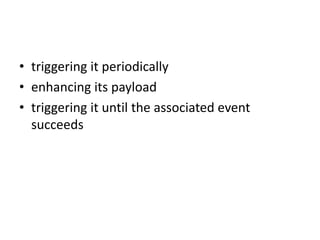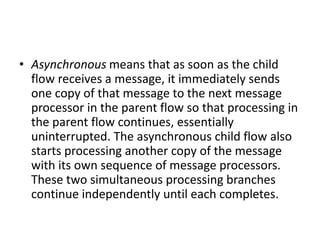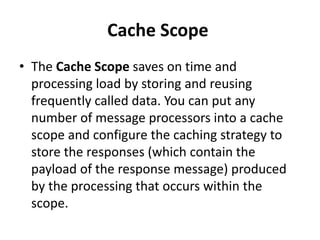Scopes in mule
- 1. Scopes in mule The message processors known as Scopes appear as processing blocks when you first place them on the Message Flow canvas. Certain scopes (i.e., Poll, Message Enricher, and Until Successful) require you to embed no more than one message processor within the processing block.
- 2. • triggering it periodically • enhancing its payload • triggering it until the associated event succeeds
- 3. • Synchronous means that processing on the main flow halts, and all the message processors in the child flow execute before the parent flow resumes processing; in other words, no processing takes place in the parent flow while the synchronous child flow is executing.
- 4. • Asynchronous means that as soon as the child flow receives a message, it immediately sends one copy of that message to the next message processor in the parent flow so that processing in the parent flow continues, essentially uninterrupted. The asynchronous child flow also starts processing another copy of the message with its own sequence of message processors. These two simultaneous processing branches continue independently until each completes.
- 5. Cache Scope • The Cache Scope saves on time and processing load by storing and reusing frequently called data. You can put any number of message processors into a cache scope and configure the caching strategy to store the responses (which contain the payload of the response message) produced by the processing that occurs within the scope.
- 6. Composite Source • To handle incoming messages from multiple input channels, place two or more message sources (also known as receivers) into a Composite Source. A message entering the Composite Source on any supported channel triggers the processing flow.
- 7. Foreach • Splits any type of message collection aside into individual messages for processing, and then aggregate them again at the end of the scope
- 8. Poll • Periodically polls an embedded message receiver for new messages. For example, set a Poll to retrieve email at regular intervals by placing a request-response connector such as SMTP within the Poll processing block.
- 9. Transactional • Mule applies the concept of transactions to operations in application for which the result cannot remain indeterminate. In other words, where a series of steps in flow must succeed or fail as one unit, Mule uses a transaction to demarcate such a unit.
- 10. Until Successful • Attempts, at a specified interval, to route a message to an embedded message processor until one of the following occurs: * it succeeds * the maximum number of retries is reached * an exception is thrown










